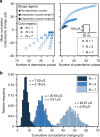Neuromorphic computing with multi-memristive synapses
- PMID: 29955057
- PMCID: PMC6023896
- DOI: 10.1038/s41467-018-04933-y
Neuromorphic computing with multi-memristive synapses
Abstract
Neuromorphic computing has emerged as a promising avenue towards building the next generation of intelligent computing systems. It has been proposed that memristive devices, which exhibit history-dependent conductivity modulation, could efficiently represent the synaptic weights in artificial neural networks. However, precise modulation of the device conductance over a wide dynamic range, necessary to maintain high network accuracy, is proving to be challenging. To address this, we present a multi-memristive synaptic architecture with an efficient global counter-based arbitration scheme. We focus on phase change memory devices, develop a comprehensive model and demonstrate via simulations the effectiveness of the concept for both spiking and non-spiking neural networks. Moreover, we present experimental results involving over a million phase change memory devices for unsupervised learning of temporal correlations using a spiking neural network. The work presents a significant step towards the realization of large-scale and energy-efficient neuromorphic computing systems.
Conflict of interest statement
The authors declare no competing interests.
Figures





References
-
- Schemmel, J. et al. A wafer-scale neuromorphic hardware system for large-scale neural modeling. In Proc. IEEE International Symposium on Circuits and Systems (ISCAS), 1947–1950 (IEEE, Paris, France, 2010).
-
- Painkras E, et al. SpiNNaker: a 1-W 18-core system-on-chip for massively-parallel neural network simulation. IEEE J. Solid-State Circuits. 2013;48:1943–1953. doi: 10.1109/JSSC.2013.2259038. - DOI
Publication types
MeSH terms
LinkOut - more resources
Full Text Sources
Other Literature Sources
Molecular Biology Databases

